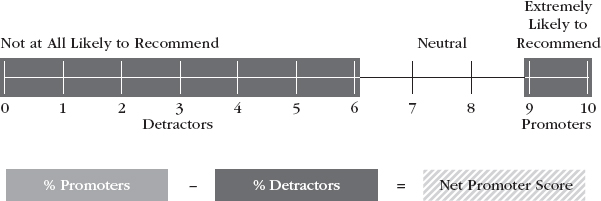Appendix B
Are Those Least Likely to Recommend Actually the Most Likely to Discourage?
As discussed in Chapter 2, Net Promoter suggests that anyone who rates their likelihood to recommend a six or below is a detrac tor (Figure B.1). This scale simply doesn’t work, and as shown in Chapter 4 and Appendix A, this calculation overstates detractors by 260 percent to 270 percent on average.
However, over time, some companies have come up with their own definitions of detractors. Some companies consider only those who rate their likelihood to recommend a one a super detractor; some companies say that anyone who answers a one or two is a super detractor.
However, there is no way to use the single “how likely are you to recommend” question as a proxy for detractors. We ran analysis on every definition of NPS-defined detractors to see how many of them say they are actually likely to discourage people from doing business with the company.
We define True Detractors as those who rate their likelihood to discourage someone from doing business with a company at a 9 or 10 on our 10-point scale. The following analysis shows how many NPS-defined promoters are actually detracting from the company, and the data underscore that likelihood to recommend cannot be used as a proxy for detraction, no matter what scale we use.
The results follow.
Figure B.1 NPS Scale

Least Likely to Recommend: 1s
When asked, ...
Get Innovating Analytics: How the Next Generation of Net Promoter Can Increase Sales and Drive Business Results now with the O’Reilly learning platform.
O’Reilly members experience books, live events, courses curated by job role, and more from O’Reilly and nearly 200 top publishers.

